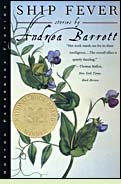|
Ship Feverby Andrea BarrettReviewed by Margaret Donsbach In "The Behavior of the Hawkweeds," set in 1970, a science professor's wife comes to resent her husband's appropriation of the tale she once revealed to him, like a rare gem, of her grandfather's childhood encounter with Gregor Mendel. In "Birds With No Feet," a nineteenth-century man jaunts to the Amazon and the Malay Archipelago on specimen-collecting expeditions. He dreams of making a noteworthy contribution to science that will justify killing the many animals he must mount and sell in order to fund his expeditions. In the novella which gives the collection its title, a second-rate Canadian physician volunteers to work on Grosse Isle, where Irish immigrants fleeing the potato famine are detained while they recover or die from typhus and other diseases before being permitted to settle on the mainland. The number of patients is too vast for the facility to handle, and it receives inadequate support. Is the doctor's stubborn, outraged compassion a hindrance to his work or the saving grace that makes it worth doing? The quiet, beautifully observed stories in Ship Fever all have a strong resemblance in tone, whether set in the late twentieth century or in the eighteenth and nineteenth centuries, suggesting that human nature is a constant that changes less over the course of time than we might think. Weaving through the stories, tying them gently together, are themes of ambition, the thirst for knowledge, and love in its many forms. (1996; 255 pages, including a brief note on the history and sources for the novella) More about Ship Fever at Powell's Books or Amazon.com
The House of Sight and Shadow by Nicholas Griffin (2000), about a pair of London doctors exploring the fringes of eighteenth century medicine as anatomists, and the rivalry that develops between them over a woman. More info Rifling Paradise by Jem Poster (2006), about a young Englishman who travels to Australia to collect bird specimens. Review or more info from Powell's Books Mr. Darwin's Shooter by Roger McDonald (1999), about Syms Covington, who assists Darwin in collecting animal specimens in the Galapagos Islands. More info
The Age of Wonder: How the Romantic Generation Discovered the Beauty and Terror of Science by Richard Holmes (2009). More info
The Grosse Isle Tragedy and the Monument to the Irish Fever Victims, 1847 by J.A. Jordan (1909). More info Eyewitness, Grosse Isle 1847 by Marianna O'Gallagher and Rose Masson Dompierre (1995). More info A Grandmother Remembers Grosse Ile by Jeannette Vekeman Masson (1989). More info
About Grosse Isle, a chapter from John Francis Maguire's 1868 book The Irish in America at LibraryIreland.com Back to Novels of Nineteenth Century North America
|
